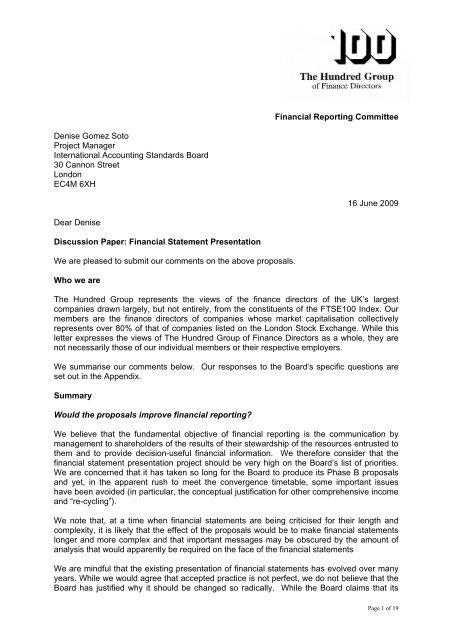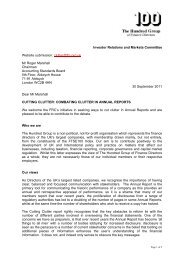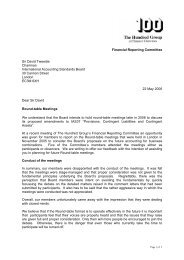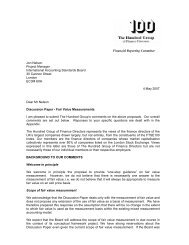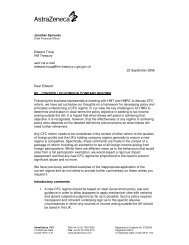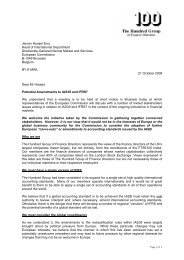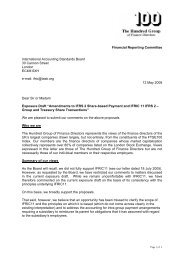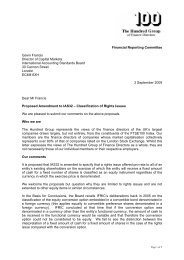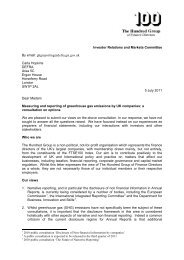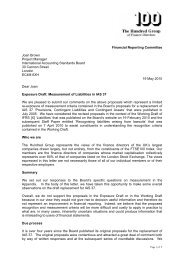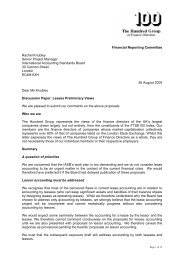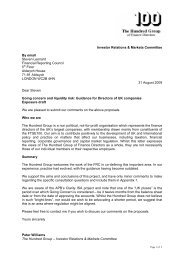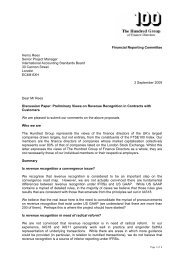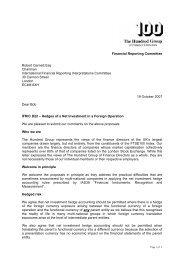Financial Reporting Committee Denise Gomez Soto Project ...
Financial Reporting Committee Denise Gomez Soto Project ...
Financial Reporting Committee Denise Gomez Soto Project ...
Create successful ePaper yourself
Turn your PDF publications into a flip-book with our unique Google optimized e-Paper software.
<strong>Denise</strong> <strong>Gomez</strong> <strong>Soto</strong><br />
<strong>Project</strong> Manager<br />
International Accounting Standards Board<br />
30 Cannon Street<br />
London<br />
EC4M 6XH<br />
Dear <strong>Denise</strong><br />
Discussion Paper: <strong>Financial</strong> Statement Presentation<br />
We are pleased to submit our comments on the above proposals.<br />
Who we are<br />
<strong>Financial</strong> <strong>Reporting</strong> <strong>Committee</strong><br />
16 June 2009<br />
The Hundred Group represents the views of the finance directors of the UK’s largest<br />
companies drawn largely, but not entirely, from the constituents of the FTSE100 Index. Our<br />
members are the finance directors of companies whose market capitalisation collectively<br />
represents over 80% of that of companies listed on the London Stock Exchange. While this<br />
letter expresses the views of The Hundred Group of Finance Directors as a whole, they are<br />
not necessarily those of our individual members or their respective employers.<br />
We summarise our comments below. Our responses to the Board’s specific questions are<br />
set out in the Appendix.<br />
Summary<br />
Would the proposals improve financial reporting?<br />
We believe that the fundamental objective of financial reporting is the communication by<br />
management to shareholders of the results of their stewardship of the resources entrusted to<br />
them and to provide decision-useful financial information. We therefore consider that the<br />
financial statement presentation project should be very high on the Board’s list of priorities.<br />
We are concerned that it has taken so long for the Board to produce its Phase B proposals<br />
and yet, in the apparent rush to meet the convergence timetable, some important issues<br />
have been avoided (in particular, the conceptual justification for other comprehensive income<br />
and “re-cycling”).<br />
We note that, at a time when financial statements are being criticised for their length and<br />
complexity, it is likely that the effect of the proposals would be to make financial statements<br />
longer and more complex and that important messages may be obscured by the amount of<br />
analysis that would apparently be required on the face of the financial statements<br />
We are mindful that the existing presentation of financial statements has evolved over many<br />
years. While we would agree that accepted practice is not perfect, we do not believe that the<br />
Board has justified why it should be changed so radically. While the Board claims that its<br />
Page 1 of 19
proposals are designed to meet the needs of users, we are not convinced that the Board has<br />
yet discussed its proposals with a sufficiently broad range of users to really understand those<br />
needs. Indeed, we sense that some of its more radical proposals are designed more to keep<br />
its presentation model conceptually pure rather than necessarily to meet the needs of users.<br />
We are not, therefore, convinced that the proposals would improve financial reporting and we<br />
suggest below ways in which we think that users’ needs could be met by making limited<br />
changes to existing practice rather than the wholesale changes that are proposed by the<br />
Board.<br />
We welcome the management approach<br />
We welcome the Board’s endorsement of the management approach. We note, however,<br />
that the Board views, and, moreover, contends that management views, performance as the<br />
movement between two balance sheets. In our experience, most companies measure<br />
performance by reference to transactions and cash flows and consider the balance sheet to<br />
be the residual (there are some exceptions, such as property and asset management<br />
businesses).<br />
As management tends to focus on transactions and cash flows, we would prefer that the<br />
classification of items in the financial statements reflects this approach rather than being<br />
based on the use of assets and liabilities.<br />
Objectives are laudable, but difficult to achieve<br />
While cohesiveness, disaggregation and liquidity and financial flexibility are laudable<br />
objectives, we believe that in practice it will be difficult to satisfy all of them in each of the<br />
primary financial statements.<br />
We are concerned that if too much detail is provided on the face of the financial statements<br />
important information will be obscured and we urge the Board to take a realistic view as to<br />
how much information it is physically possible to present on the face of the financial<br />
statements.<br />
We believe that cohesiveness is appropriate in the context of the income statement and the<br />
cash flow statement (indeed, we believe that cohesiveness is already largely achieved under<br />
existing standards) but we believe that adherence to cohesiveness in the balance sheet may<br />
obscure important information on liquidity and therefore would conflict with one of the other<br />
proposed objectives.<br />
We believe that the basis for disaggregation on the face of the financial statements should be<br />
at the level that is used by the entity’s management to manage the business (either by nature<br />
or by function). We agree that where expenses are analysed by function on the face of the<br />
financial statements they should be analysed by nature in the notes, but it is important that<br />
the level of analysis should be relevant in the context of the reporting entity. We believe that<br />
analysis contained in the Illustrations is unnecessarily detailed for an international group<br />
such as ToolCo.<br />
We believe that a clear portrayal of an entity’s liquidity is important: particularly in the current<br />
economic environment. We therefore consider that liquidity information should be presented<br />
on the face of the balance sheet and are concerned that the Board appears content to<br />
subordinate the liquidity objective to the cohesiveness and disaggregation objectives and<br />
relegate liquidity disclosures to the notes.<br />
Page 2 of 19
One size doesn’t fit all<br />
Businesses differ both in their business models and the way they are managed and it is<br />
therefore entirely appropriate that differences should be permitted in the presentation of their<br />
financial statements. We believe that it would undermine the usefulness of the primary<br />
financial statements if the Board were to mandate rigid presentation requirements that apply<br />
to all companies.<br />
Rather, we believe that the Board should set out a broad framework, specifying certain<br />
headings that must be presented on the face of the financial statements but permitting<br />
additional analysis to be presented where considered appropriate by management. Such an<br />
approach already prevails under IAS1.<br />
Within that framework, decisions on the categorisation of items as operating, investing or<br />
financing and the appropriate level of disaggregation should reside with management. We<br />
believe that, as is the case now, such an approach would enable companies within particular<br />
industries to adopt similar approaches that would assist comparison with their peers.<br />
Companies do talk to users and take into account their requests for additional analysis and<br />
explanation.<br />
Such an approach would be principles-based. We believe that the Board must be careful<br />
that this project does not lean towards the rules-based, “tick box” approach to financial<br />
reporting that has developed in other jurisdictions.<br />
What is other comprehensive income?<br />
When we commented on Phase A of the financial statement presentation project back in<br />
July 2006, we said that we were not necessarily opposed in principle to there being one<br />
performance statement. We maintain this view but now, as then, we believe that it is not just<br />
a question of whether there should be one statement or two, but also of how items should be<br />
presented within them.<br />
While we welcome the Board’s decision to retain sub-totals to identify traditional performance<br />
measures (in particular, net income), we consider that the issues surrounding the definition of<br />
other comprehensive income and when items should be “re-cycled” to net income have<br />
been avoided. As things stand, there is little or no conceptual justification for the<br />
components of other comprehensive income. We acknowledge the pressures of the<br />
convergence timetable but do not believe that any standard on financial statement<br />
presentation could be described as principles-based without having addressed these issues.<br />
We suggest that the Board takes into consideration the recent discussion paper issued by<br />
EFRAG and European national standard-setters under the PAAinE initiative which does<br />
attempt to address these issues.<br />
Cash flow or net debt reconciliation?<br />
We consider that it is unfortunate that the discussion concerning the cash flow statement has<br />
focussed on the direct versus indirect method of presenting operating cash flows. We<br />
consider this to be a distraction.<br />
We do not believe that the Board has given sufficient consideration to the purpose of the<br />
cash flow statement. Most companies manage a measure of net debt rather than narrow<br />
cash and a cash flow statement that reflects this commercial reality would both significantly<br />
improve the decision-usefulness of the statement and be consistent with the management<br />
approach. As the Board will be aware, the Corporate <strong>Reporting</strong> Users Forum recently<br />
requested the Board to mandate a reconciliation of the cash flow statement to the movement<br />
Page 3 of 19
in net debt and this is provided on a voluntary basis by many UK companies (who were used<br />
to providing it under the UK standard, FRS1).<br />
Why mandate the direct cash flow method?<br />
We are not opposed to the direct method of presenting operating cash flows in principle but<br />
we have yet to be convinced as to exactly why users believe that it is preferable to the<br />
indirect method. Indeed, we question whether the direct method has been proposed by the<br />
Board in response to widespread demands from users but rather to keep its proposals<br />
conceptually pure as it considers that the indirect method would be incompatible with<br />
cohesiveness.<br />
Companies already have the option to use the direct method under IAS7. We believe that<br />
the fact that very few actually use the direct method demonstrates that very few capture the<br />
necessary information and that this, in turn, indicates that they do not use direct cash flow<br />
information to manage their businesses. We therefore contend that any move to mandate<br />
the direct method would in most cases be incompatible with the management approach that<br />
underlies the current proposals.<br />
We understand that users wish to gain a better understanding of how operating cash flows<br />
relate to the income statement. However, we do not believe that it this necessitates the use<br />
of the direct method. We suggest that this could be achieved by providing greater<br />
transparency around the reconciliation of profit or loss to cash generated from operations. In<br />
particular, we suggest that:<br />
a) the reconciliation should start with operating profit rather than net income; and<br />
b) an analysis should be provided of the movement on assets and liabilities included in the<br />
reconciliation (showing items reflected in profit or loss, the effect of acquisitions and<br />
disposals, currency translation differences and cash flows).<br />
Essentially, companies would be required to show their workings in arriving at cash<br />
generated from operations. We believe that this approach would provide users with much of<br />
the information they seek without the expense to preparers of re-configuring their accounting<br />
reporting systems to capture direct cash flow information.<br />
We do not support the income statement to cash flow reconciliation<br />
We recognise that the reconciliation might help users understand the relationship between<br />
the income statement and the cash flow statement. However, we suspect that any interest<br />
from users in this reconciliation has arisen because the income statement has become so<br />
subject to valuations that they no longer understand it, and they feel the need to reconcile it<br />
to something they do understand, i.e. cash.<br />
We believe that the reconciliation can be produced only if: a) expenses are disaggregated by<br />
nature in the income statement; and b) the direct method is used to measure operating cash<br />
flows. For most entities these features are likely to be incompatible with the management<br />
approach that supposedly underlies the proposals. As we do not agree with these aspects of<br />
the proposals, we do not support the reconciliation.<br />
We consider the reconciliation to be too detailed and that it includes many items of limited<br />
information value. Its primary benefit is to highlight the effects of changes in fair values.<br />
While this is important, we believe that there are other, simpler ways of conveying this<br />
information.<br />
Exceptional items and “non-GAAP” measures should be permitted<br />
While there is currently no notion of unusual or infrequent events or transactions in IFRSs,<br />
we believe strongly that there should be. Moreover, we recommend that the notion of an<br />
Page 4 of 19
“exceptional item” should be introduced into IFRSs with a definition along the lines of that<br />
which prevails in the UK accounting standard, FRS3, i.e. “material items which derive from<br />
events or transactions that….need to be disclosed by virtue of their size or incidence if the<br />
financial statements are to give a true and fair view”. We do not understand why the Board is<br />
so implacably opposed to the disclosure of such items on the face of the income statement.<br />
Surely, if one of the objectives of financial statements is to enable users to predict future<br />
cash flows, it is important that they are able to identify unusual or infrequent items.<br />
We would go further and recommend that, as part of the financial statement presentation<br />
project, the Board addresses the issue of “non-GAAP measures”. Consistent with the<br />
management approach, we believe that if management uses non-GAAP measures to<br />
manage the business they should be permitted to be presented in the financial statements<br />
(provided, of course, they are reconciled to the nearest equivalent GAAP measures). While<br />
this principle is recognised by IFRS8, and FAS131 for that matter, it is sadly ignored in other<br />
contexts.<br />
Presentation of acquisitions and disposals should be considered<br />
We are aware that some users have requested more clarity concerning the accounting for<br />
acquisitions and disposals. We suspect that their current difficulties are two-fold: a)<br />
understanding the acquisition or disposal transaction; and b) understanding the effects of the<br />
acquisition or disposal on the entity’s results. We suggest that their needs could be<br />
addressed by way of a review of the disclosures required in relation to acquisitions under<br />
IFRS3 and by mandating similar disclosures in respect of disposals and considering the<br />
presentation of the results of acquisitions and disposals on the face of the income statement.<br />
We believe that both the presentation and the definition of discontinued operations should<br />
have been considered as part of the financial statement presentation project, rather than on<br />
a piecemeal basis (the definition having been addressed in the recent proposed<br />
amendments to IFRS5). We believe that discontinued operations should be defined simply<br />
as businesses that have been sold or exited before the date of approval of the financial<br />
statements (the current rules are confusing as they lead to the inclusion in “discontinued” of<br />
businesses in which the entity is still involved and the inclusion in “continuing” of businesses<br />
that have been sold or exited).<br />
With regard to the cash flow statement, we recognise that the Board has not reached a<br />
preliminary view on how to classify and present the effects acquisitions and disposals.<br />
However, we would object strongly to any future proposals to allocate the income and cash<br />
flow effects of acquisitions and disposals to the sections or categories in which the<br />
underlying assets or liabilities are classified because this would not faithfully represent the<br />
acquisition and disposal transactions which are typically transactions in shares, not in the<br />
assets and liabilities that underlie the shares.<br />
Please feel free to contact me if you wish to discuss our comments on the proposals.<br />
Yours sincerely<br />
Chris Lucas<br />
Chairman<br />
The Hundred Group - <strong>Financial</strong> <strong>Reporting</strong> <strong>Committee</strong><br />
E: chris.lucas@barclays.com<br />
Page 5 of 19
CHAPTER 2: OBJECTIVES AND PRINCIPLES OF FINANCIAL STATEMENT<br />
PRESENTATION<br />
Question 1<br />
APPENDIX<br />
Would the objectives of financial statement presentation proposed in paragraphs 2.5–<br />
2.13 improve the usefulness of the information provided in an entity’s financial<br />
statements and help users make better decisions in their capacity as capital<br />
providers? Why or why not? Should the boards consider any other objectives of<br />
financial statement presentation in addition to or instead of the objectives proposed in<br />
this discussion paper? If so, please describe and explain.<br />
While cohesiveness, disaggregation and liquidity and financial flexibility are laudable<br />
objectives, we believe that in practice it will be difficult to satisfy all of them in each of the<br />
primary financial statements.<br />
We are concerned that if too much detail is provided on the face of the financial statements<br />
important information will be obscured and we urge the Board to take a realistic view as to<br />
how much information it is physically possible to present on the face of the financial<br />
statements.<br />
Cohesiveness<br />
We believe that cohesiveness is appropriate in the context of the income statement and the<br />
cash flow statement (indeed, we believe that cohesiveness is already largely achieved under<br />
existing standards) but we believe that adherence to cohesiveness in the balance sheet may<br />
obscure important information on liquidity and therefore would conflict with one of the other<br />
proposed objectives.<br />
Disaggregation<br />
We believe that the basis for disaggregation on the face of the financial statements should be<br />
at the level that is used by the entity’s management to manage the business (either by nature<br />
or by function).<br />
We sense that the Board would have preferred to mandate disaggregation of expenses by<br />
nature. We are concerned that this was borne out of the realisation that disaggregation by<br />
function would not be compatible with the direct method of presenting operating cash flows,<br />
rather than a real understanding of users needs.<br />
We consider disaggregation in more detail in our response to Question 16.<br />
Liquidity and financial flexibility<br />
We believe that a clear portrayal of an entity’s liquidity is important: particularly in the current<br />
economic environment. We therefore consider that liquidity information should be presented<br />
on the face of the balance sheet and are concerned that the Board appears content to<br />
subordinate the liquidity objective to the cohesiveness and disaggregation objectives and<br />
relegate liquidity disclosures to the notes.<br />
An entity’s liquidity and financial flexibility is likely to be at least as dependent on financing<br />
arrangements that are not shown on the face of the balance sheet (e.g. committed headroom<br />
under borrowing facilities) as on the assets and liabilities that are shown on the face of the<br />
Page 6 of 19
alance sheet. We therefore believe that the disclosures proposed under the financial<br />
statement presentation project should be considered in the context of the disclosures about<br />
liquidity risk required under IFRS7.<br />
Question 2<br />
Would the separation of business activities from financing activities provide<br />
information that is more decision-useful than that provided in the financial statement<br />
formats used today (see paragraph 2.19)? Why or why not?<br />
As far as the income statement and the cash flow statement are concerned, we do not<br />
believe that the concept of separating business from financing is anything new as most<br />
entities already provide this analysis.<br />
As we commented in our answer to Question 1, we do not believe that cohesiveness lends<br />
itself particularly well to the balance sheet and we believe that the analysis between business<br />
and financing of certain assets and liabilities may be problematic (for example, cash and<br />
cash equivalents, leases and post-employment benefit obligations). We acknowledge that<br />
the Board has proposed that if an entity cannot clearly identify and asset or liability as<br />
relating to operating investing or financing activities, it should presume that the asset or<br />
liability relates to its operating activities. While this is a pragmatic approach, we believe that<br />
the need for the default calls into question the robustness of the proposals.<br />
With regard to the balance sheet, we would prefer that the financing activities of a business<br />
are identified by a requirement to present a measure of net debt in the notes to the financial<br />
statements. We believe that this approach would be consistent with the recent request from<br />
users that entities should be required to present a reconciliation between the cash flow<br />
statement and the movement in net debt (we return to this issue in our answer to<br />
Question 10).<br />
Question 3<br />
Should equity be presented as a section separate from the financing section or should<br />
it be included as a category in the financing section (see paragraphs 2.19(b), 2.36 and<br />
2.52–2.55)? Why or why not?<br />
We believe that equity should be presented separately from financing because, by definition,<br />
equity is not a liability, and not to present it separately could be misleading to users.<br />
We remain concerned about the direction of the Board’s deliberations on the distinction<br />
between equity and liabilities (as outlined in our comment letter on the recent Discussion<br />
Paper “<strong>Financial</strong> Instruments with the Characteristics of Equity”).<br />
Question 4<br />
In the proposed presentation model, an entity would present its discontinued<br />
operations in a separate section (see paragraphs 2.20, 2.37 and 2.71–2.73). Does this<br />
presentation provide decision-useful information? Instead of presenting this<br />
information in a separate section, should an entity present information about its<br />
discontinued operations in the relevant categories (operating, investing, financing<br />
assets and financing liabilities)? Why or why not?<br />
We believe that it is useful to identify the results of discontinued operations because it assists<br />
users in predicting the future performance of the entity.<br />
Page 7 of 19
We are aware that some commentators would prefer that discontinued operations are<br />
presented in a columnar format rather than as a separate section. While we would not object<br />
to a columnar presentation, we are content with the existing presentation as a separate<br />
section.<br />
We believe that both the presentation and the definition of discontinued operations should<br />
have been considered as part of the financial statement presentation project, rather than on<br />
a piecemeal basis (the definition having been addressed in the recent proposed<br />
amendments to IFRS5).<br />
We believe that discontinued operations should be defined simply as businesses that have<br />
been sold or exited before the approval of the financial statements. We contend that the<br />
current rules are confusing in that they result in the inclusion in “discontinued” of businesses<br />
in which the entity is still involved, i.e. that most people would think of as “continuing” and the<br />
inclusion in “continuing” of businesses that have been sold or exited, i.e. that most people<br />
would think of as “discontinued”.<br />
We recommend that the Board should also address as part of the financial statement<br />
presentation project the measurement and presentation of assets held for sale. We do not<br />
believe that assets held for sale should cease to be depreciated, nor that there is any benefit<br />
in presenting assets held for sale and associated liabilities separately on the face of the<br />
balance sheet (especially as this would further complicate a cohesive, disaggregated<br />
balance sheet).<br />
We also suggest that the Board addresses the presentation in the income statement of<br />
businesses acquired during the period as this is likely to be equally important in predicting<br />
the future performance of the entity.<br />
Question 5<br />
The proposed presentation model relies on a management approach to classification<br />
of assets and liabilities and the related changes in those items in the sections and<br />
categories in order to reflect the way an item is used within the entity or its reportable<br />
segment (see paragraphs 2.27, 2.34 and 2.39–2.41).<br />
(a) Would a management approach provide the most useful view of an entity to users<br />
of its financial statements?<br />
We believe that financial reporting is fundamentally about the communication by<br />
management to shareholders of the results of their stewardship of the resources entrusted to<br />
them. We therefore welcome the Board’s endorsement of the management approach.<br />
We remain concerned, however, that the Board views, and, moreover, contends that<br />
management views, performance as the movement between two balance sheets. In our<br />
experience, most companies measure performance by reference to transactions and cash<br />
flows and consider the balance sheet to be the residual (there are some exceptions, such as<br />
property and asset management businesses).<br />
As management tends to focus on transactions and cash flows we would therefore prefer<br />
that the classification of items in the financial statements reflects this approach rather than<br />
being based on the use of assets and liabilities.<br />
Page 8 of 19
(b) Would the potential for reduced comparability of financial statements resulting<br />
from a management approach to classification outweigh the benefits of that<br />
approach? Why or why not?<br />
Businesses differ both in their business models and the way they are managed and it is<br />
therefore entirely appropriate that differences should be permitted in the presentation of their<br />
financial statements. We believe that it would undermine the usefulness of the primary<br />
financial statements if the Board were to mandate rigid presentation requirements that apply<br />
to all companies.<br />
Rather, we believe that the Board should set out a broad framework, specifying certain<br />
headings that must be presented on the face of the financial statements but permitting<br />
additional analysis to be presented where considered appropriate by management (including<br />
the presentation of so-called “non-GAAP” measures, which we address in our answer to<br />
Question 26). Such an approach already prevails under IAS1.<br />
Within that framework, decisions on the categorisation of items as operating, investing or<br />
financing and the appropriate level of disaggregation should reside with management. We<br />
believe that, as is the case now, such an approach would enable companies within particular<br />
industries to adopt similar approaches that would assist comparison with their peers.<br />
Companies do talk to users and take into account their requests for additional analysis and<br />
explanation.<br />
Such an approach would be principles-based. We believe that the Board must be careful<br />
that this project does not lean towards the rules-based, “tick box” approach to financial<br />
reporting that has developed in other jurisdictions.<br />
Question 6<br />
Paragraph 2.27 proposes that both assets and liabilities should be presented in the<br />
business section and in the financing section of the statement of financial position.<br />
Would this change in presentation coupled with the separation of business and<br />
financing activities in the statements of comprehensive income and cash flows make<br />
it easier for users to calculate some key financial ratios for an entity’s business<br />
activities or its financing activities? Why or why not?<br />
As we commented in our answer to Question 1, we do not believe that cohesiveness lends<br />
itself particularly well to the balance sheet. We are concerned that the inclusion of both<br />
assets and liabilities in the business and financing sections of the balance sheet would<br />
conflict with the objective of liquidity and financial flexibility.<br />
While the proposed format may make the calculation of certain ratios easier, it may make the<br />
calculation of others harder. We suggest that the Board discusses this with users and in the<br />
eventual exposure draft explains, with examples, why cohesiveness makes it easier for users<br />
to calculate key financial ratios.<br />
We are mindful that, with the existence of XBRL technology, it should not matter how the<br />
information required for calculating ratios is presented provided that it is presented<br />
somewhere in the financial statements.<br />
Page 9 of 19
Question 7<br />
Paragraphs 2.27, 2.76 and 2.77 discuss classification of assets and liabilities by<br />
entities that have more than one reportable segment for segment reporting purposes.<br />
Should those entities classify assets and liabilities (and related changes) at the<br />
reportable segment level as proposed instead of at the entity level? Please explain.<br />
We are mindful that there may be some situations in which the classification of assets and<br />
liabilities would be different at a segment level and the entity level. We therefore believe that<br />
assets and liabilities should be classified on the basis of the management approach applied<br />
at the entity level.<br />
Question 8<br />
The proposed presentation model introduces sections and categories in the<br />
statements of financial position, comprehensive income and cash flows. As discussed<br />
in paragraph 1.21(c), the boards will need to consider making consequential<br />
amendments to existing segment disclosure requirements as a result of the proposed<br />
classification scheme. For example, the boards may need to clarify which assets<br />
should be disclosed by segment: only total assets as required today or assets for<br />
each section or category within a section. What, if any, changes in segment<br />
disclosures should the boards consider to make segment information more useful in<br />
light of the proposed presentation model? Please explain.<br />
IFRS8 requires that segment information is presented in financial statements only if it is<br />
reported to the chief operating decision maker (indeed, it has only recently been revised to<br />
remove the requirement to present an analysis of total assets by operating segment, unless<br />
that information is provided to the chief operating decision maker).<br />
We would not welcome any change to IFRS8 in this respect as it would be inconsistent with<br />
the management approach.<br />
Question 9<br />
Are the business section and the operating and investing categories within that<br />
section defined appropriately (see paragraphs 2.31–2.33 and 2.63–2.67)? Why or why<br />
not?<br />
We believe that the definitions are appropriate and consistent with a principles-based<br />
approach.<br />
We expect that some difficulties will arise in practice but suggest that the Board encourages<br />
companies to be transparent and explain the reasons for their presentation of item whose<br />
classification is ambiguous under the definitions.<br />
Question 10<br />
Are the financing section and the financing assets and financing liabilities categories<br />
within that section defined appropriately (see paragraphs 2.34 and 2.56–2.62)? Should<br />
the financing section be restricted to financial assets and financial liabilities as<br />
defined in IFRSs and US GAAP as proposed? Why or why not?<br />
If it is decided to proceed with the principle of cohesiveness in the balance sheet, we agree<br />
that the financing section should be restricted to “financial assets” and “financial liabilities” as<br />
defined in IFRSs that management views as part of the financing of the entity’s business (we<br />
Page 10 of 19
understand that in this context there is no restriction to the financial assets and financial<br />
liabilities that fall within the scope of IAS39).<br />
As we indicated in our answer to Question 2, we would prefer that disclosure of net debt in<br />
the notes to the financial statements is substituted for the presentation of a financing section<br />
on the face of the balance sheet.<br />
CHAPTER 3: IMPLICATIONS OF THE OBJECTIVES AND PRINCIPLES FOR EACH<br />
FINANCIAL STATEMENT<br />
Question 11<br />
Paragraph 3.2 proposes that an entity should present a classified statement of<br />
financial position (short-term and long-term subcategories for assets and liabilities)<br />
except when a presentation of assets and liabilities in order of liquidity provides<br />
information that is more relevant.<br />
(a) What types of entities would you expect not to present a classified statement of<br />
financial position? Why?<br />
We expect that financial institutions are likely to present their balance sheets in order of<br />
liquidity (as most do now).<br />
(b) Should there be more guidance for distinguishing which entities should present a<br />
statement of financial position in order of liquidity? If so, what additional guidance is<br />
needed?<br />
We do not believe that the Board needs to be any more prescriptive as to when presentation<br />
of the balance sheet in order of liquidity provides information that is more relevant. We<br />
believe that this should be left to management to assess in the context of the entity’s<br />
business, but they should be required to explain why they have adopted the liquidity<br />
approach rather than a classified presentation.<br />
We do not support the removal of the reference to the entity’s normal operating cycle from<br />
the definition of “short-term” as this is important to enable a meaningful presentation of<br />
assets and liabilities in certain industries.<br />
Question 12<br />
Paragraph 3.14 proposes that cash equivalents should be presented and classified in<br />
a manner similar to other short-term investments, not as part of cash. Do you agree?<br />
Why or why not?<br />
We believe that distinction should be drawn between short-term instruments that are used for<br />
treasury management purposes and short-term instruments that may be held for other<br />
purposes.<br />
We are content with the current presentation of cash and cash equivalents in the balance<br />
sheet. If cash were to be required to be shown separately, the distinction should be drawn<br />
between cash equivalents and other short-term investments.<br />
Page 11 of 19
Question 13<br />
Paragraph 3.19 proposes that an entity should present its similar assets and liabilities<br />
that are measured on different bases on separate lines in the statement of financial<br />
position. Would this disaggregation provide information that is more decision-useful<br />
than a presentation that permits line items to include similar assets and liabilities<br />
measured on different bases? Why or why not?<br />
Consistent with our answer to Question 1, we do not consider that it is necessary to draw the<br />
distinction between similar assets and liabilities measured on different on the face of the<br />
balance sheet.<br />
We believe that it is sufficient for this information to be presented in the notes to the financial<br />
statements (with respect to financial instruments, this information is already presented in the<br />
notes in accordance with IFRS7).<br />
Question 14<br />
Should an entity present comprehensive income and its components in a single<br />
statement of comprehensive income as proposed (see paragraphs 3.24–3.33)? Why or<br />
why not? If not, how should they be presented?<br />
When we commented on Phase A of the financial statement presentation project back in<br />
July 2006, we said that we were not necessarily opposed in principle to there being one<br />
performance statement. We maintain this view but now, as then, we believe that it is not just<br />
a question of whether there should be one statement or two, but also of how items should be<br />
presented within them.<br />
While we welcome the Board’s decision to retain sub-totals to identify traditional performance<br />
measures (in particular, net income), we are concerned that the issues surrounding the<br />
definition of other comprehensive income and when items should be “re-cycled” to net<br />
income have been avoided. As things stand, there is little or no conceptual justification for<br />
the components of other comprehensive income. We acknowledge the pressures of the<br />
convergence timetable but do not believe that any standard on financial statement<br />
presentation could be described as principles-based without having addressed these issues.<br />
We suggest that the Board takes into consideration the recent discussion paper issued by<br />
EFRAG and European national standard-setters under the PAAinE initiative which does<br />
attempt to address these issues.<br />
Question 15<br />
Paragraph 3.25 proposes that an entity should indicate the category to which items of<br />
other comprehensive income relate (except some foreign currency translation<br />
adjustments) (see paragraphs 3.37–3.41). Would that information be decision-useful?<br />
Why or why not?<br />
We are not convinced that this information would be decision-useful but it may help users<br />
reconcile between the financial statements.<br />
If, as is proposed, currency translation adjustments on investments in foreign operations are<br />
excluded from this requirement, the items that would be affected would typically be gains and<br />
losses on cash flow hedges, gains and losses on available-for-sale investments, actuarial<br />
gains and losses in relation to post-employment benefits and, of course, tax related to those<br />
items. It is likely that each of these items would need to be allocated to more than one<br />
Page 12 of 19
category. As a result, this requirement would further complicate the income statement while<br />
being of little benefit to users.<br />
As we indicated in our answer to Question 14, we believe that it is more important that the<br />
Board considers the concept of other comprehensive income rather than the cohesiveness of<br />
the presentation of its components.<br />
Question 16<br />
Paragraphs 3.42–3.48 propose that an entity should further disaggregate within each<br />
section and category in the statement of comprehensive income its revenues,<br />
expenses, gains and losses by their function, by their nature, or both if doing so will<br />
enhance the usefulness of the information in predicting the entity’s future cash flows.<br />
Would this level of disaggregation provide information that is decision-useful to users<br />
in their capacity as capital providers? Why or why not?<br />
We are concerned that if too much detail is provided on the face of the financial statements<br />
important information will be obscured.<br />
At present, entities are required to analyse expenses either by nature or by function<br />
(whichever provides information that is reliable and more relevant). Entities classifying<br />
expenses by function are required to disclose additional information on the nature of certain<br />
expenses.<br />
As we commented in our answer to Question 1, we believe that the basis for disaggregation<br />
on the face of the financial statements should be at the level that is used by the entity’s<br />
management to manage the business (either by nature or by function). Against that<br />
background, we are concerned about the level of disaggregation that is suggested by the<br />
Illustrations. ToolCo is assumed to be a global manufacturer and marketer of power tools<br />
and accessories, hardware and home improvement products. We find it very unlikely that<br />
ToolCo’s group management, nor users of its financial statements, will be interested, for<br />
example, in the analysis of transport overheads between the wages of drivers and<br />
maintenance staff, fuel and materials as is suggested in the illustration of ToolCo (we<br />
consider that this level of detail is likely to be relevant only to management at business unit<br />
level).<br />
We recognise that many users are interested in the analysis of expenses by nature because<br />
this gives them an understanding of the fixed versus variable costs of a business which is<br />
important in assessing operational flexibility and predicting future cash flows. We therefore<br />
suggest that disclosure of expenses by nature should be provided in the notes where it is not<br />
provided on the face of the financial statements.<br />
We explain in our answer to Question 19 our opposition to the direct method of presenting<br />
operating cash flows. However, we recognise that, if the direct method was to be mandated,<br />
it is unlikely that cohesiveness between the income statement and the cash flow statement<br />
could be achieved without also mandating the analysis of expenses by nature on the face of<br />
the income statement.<br />
Page 13 of 19
Question 17<br />
Paragraph 3.55 proposes that an entity should allocate and present income taxes<br />
within the statement of comprehensive income in accordance with existing<br />
requirements (see paragraphs 3.56–3.62). To which sections and categories, if any,<br />
should an entity allocate income taxes in order to provide information that is decisionuseful<br />
to users? Please explain.<br />
We support the Board’s proposals, except we encourage the Board to reverse the recent<br />
amendment to IAS1 that requires income tax to be allocated among the components of other<br />
comprehensive income because it is inconsistent with the presentation of income tax in<br />
arriving at net income (we made this point in our comments on Phase A of the financial<br />
statement presentation project back in July 2006).<br />
Income tax is levied on an entity’s taxable profits as a whole and should therefore be<br />
presented in aggregate in arriving at net income. Any allocation of income tax between the<br />
components of net income is likely to be arbitrary and, in our opinion, would be of little or no<br />
use to users of financial statements. While the concept of other comprehensive income<br />
remains it will, however, be necessary to allocate income tax between net income and other<br />
comprehensive income.<br />
Question 18<br />
Paragraph 3.63 proposes that an entity should present foreign currency transaction<br />
gains and losses, including the components of any net gain or loss arising on<br />
remeasurement into its functional currency, in the same section and category as the<br />
assets and liabilities that gave rise to the gains or losses.<br />
(a) Would this provide decision-useful information to users in their capacity as capital<br />
providers? Please explain why or why not and discuss any alternative methods of<br />
presenting this information.<br />
We agree that the presentation of foreign currency transaction gains and losses should<br />
follow the nature of the transactions to which they are linked (in the lack of specific guidance<br />
in IFRSs, we believe that this is the current practice of many preparers).<br />
We observe that the Board has avoided the issues surrounding the presentation of foreign<br />
currency translation gains and losses by section and category by excluding them from the<br />
scope of the proposals on which we comment in our answer to Question 15.<br />
(b) What costs should the boards consider related to presenting the components of<br />
net foreign currency transaction gains or losses for presentation in different<br />
sections and categories?<br />
We do not believe that the costs would be prohibitive (indeed we are puzzled why the Board<br />
has asked about costs specifically in relation to this aspect of the proposals).<br />
Page 14 of 19
Question 19<br />
Paragraph 3.75 proposes that an entity should use a direct method of presenting cash<br />
flows in the statement of cash flows.<br />
(a) Would a direct method of presenting operating cash flows provide information<br />
that is decision-useful?<br />
We consider that it is unfortunate that the discussion concerning the cash flow statement has<br />
focussed on the direct versus indirect method of presenting operating cash flows. We<br />
consider this to be a distraction.<br />
We do not believe that the Board has given sufficient consideration to the purpose of the<br />
cash flow statement. Most companies manage a measure of net debt rather than narrow<br />
cash and a cash flow statement that reflected this commercial reality would both significantly<br />
improve the decision usefulness of the statement and be consistent with the management<br />
approach. As the Board will be aware, the Corporate <strong>Reporting</strong> Users Forum recently<br />
requested the Board to mandate a reconciliation of the cash flow statement to the movement<br />
in net debt and this is provided on a voluntary basis by many UK companies.<br />
We are not opposed to the direct method of presenting operating cash flows in principle but<br />
we have yet to be convinced as to exactly why users believe that it is preferable to the<br />
indirect method.<br />
Companies already have the option to use the direct method under IAS7. We believe that<br />
the fact that very few actually use the direct method demonstrates that very few capture the<br />
necessary information and that this, in turn, indicates that they do not use direct cash flow<br />
information to manage their businesses. We therefore contend that any move to mandate<br />
the direct method would in most cases be incompatible with the management approach that<br />
underlies the current proposals.<br />
We understand that users wish to gain a better understanding of how operating cash flows<br />
relate to the income statement. However, we do not believe that it this necessitates the use<br />
of the direct method. We suggest that this could be achieved by providing greater<br />
transparency around the reconciliation of profit or loss to cash generated from operations. In<br />
particular, we suggest that:<br />
a) the reconciliation should start with operating profit rather than net income; and<br />
b) an analysis should be provided of the movement on assets and liabilities included in the<br />
reconciliation (showing items reflected in profit or loss, the effect of acquisitions and<br />
disposals, currency translation differences and cash flows).<br />
Essentially, companies would be required to show their workings in arriving at cash<br />
generated from operations. We believe that this approach would provide users with much of<br />
the information they seek without the expense to preparers on which we comment in our<br />
answer to Question 20.<br />
(b) Is a direct method more consistent with the proposed cohesiveness (sic) and<br />
disaggregation objectives (see paragraphs 3.75–3.80) than an indirect method?<br />
Why or why not?<br />
We contend that the direct method is more consistent with the cohesiveness and<br />
disaggregation objectives only if the analysis of expenses by nature on the face of the<br />
income statement is mandated. As we explained in our answer to Question 16, we believe<br />
that this would be inconsistent with the management approach.<br />
Page 15 of 19
(c) Would the information currently provided using an indirect method to present<br />
operating cash flows be provided in the proposed reconciliation schedule (see<br />
paragraphs 4.19 and 4.45)? Why or why not?<br />
We believe that this information could be extracted from the reconciliation schedule (we<br />
comment further on the reconciliation schedule in our response to Question 23).<br />
Question 20<br />
What costs should the boards consider related to using a direct method to present<br />
operating cash flows (see paragraphs 3.81–3.83)? Please distinguish between one-off<br />
or one-time implementation costs and ongoing application costs. How might those<br />
costs be reduced without reducing the benefits of presenting operating cash receipts<br />
and payments?<br />
We believe that the incremental costs associated with the direct method would be one-time<br />
implementation costs associated with re-configuring accounting systems not just at group<br />
level but, more significantly, at the level of each of an entity’s business units.<br />
We would obviously not wish to incur these costs in the current environment, but our<br />
objection to the direct method is not based solely on cost considerations. We simply do not<br />
see why we should be required to re-configure our accounting systems to collect information<br />
for external reporting purposes that we do not use in running our businesses and that we<br />
have yet to be convinced is actually required by users.<br />
Question 21<br />
On the basis of the discussion in paragraphs 3.88–3.95, should the effects of basket<br />
transactions be allocated to the related sections and categories in the statement of<br />
comprehensive income and the statement of cash flows to achieve cohesiveness? If<br />
not, in which section or category should those effects be presented?<br />
We recognise that the Board has not reached a preliminary view on how to classify and<br />
present the effects of “basket transactions” (acquisitions and disposals). However, we would<br />
object strongly to any future proposals to allocate the income and cash flow effects of basket<br />
transactions to the sections or categories in which the underlying assets or liabilities are<br />
classified because this would not fairly represent the transactions. Acquisitions and<br />
disposals are typically transactions in shares, not in the assets and liabilities that underlie the<br />
shares. Within the framework proposed by the Board, we suggest that the effects of<br />
acquisitions and disposals should be dealt with in the investing section of the income<br />
statement and the cash flow statement.<br />
We are aware that some users have requested more clarity concerning the accounting for<br />
acquisitions and disposals. We suspect that their current difficulties are two-fold: a)<br />
understanding the acquisition or disposal transaction; and b) understanding the effects of the<br />
acquisition or disposal on the entity’s results.<br />
We suggest that their needs could be addressed by way of:<br />
a) a review of the disclosures required in relation to acquisitions under IFRS3 and by<br />
mandating similar disclosures in respect of disposals;<br />
b) clearer presentation of the results of acquisitions and disposals as suggested in our<br />
response to Question 4.<br />
Page 16 of 19
CHAPTER 4: NOTES TO THE FINANCIAL STATEMENTS<br />
Question 22<br />
Should an entity that presents assets and liabilities in order of liquidity in its<br />
statement of financial position disclose information about the maturities of its shortterm<br />
contractual assets and liabilities in the notes to financial statements as proposed<br />
in paragraph 4.7? Should all entities present this information? Why or why not?<br />
We do not believe that cohesiveness lends itself particularly well to the balance sheet and is<br />
likely to obscure important information about liquidity.<br />
We agree that entities that choose to present assets and liabilities in order of liquidity should<br />
be required to provide an analysis of their assets and liabilities between short-term and longterm.<br />
However, it is important that these disclosures for financial assets and liabilities are<br />
consistent with the disclosures that are already required to be made under IFRS7 without<br />
duplication and without being similar, but not the same. With this in mind, we are<br />
concerned, for example, that the Board has introduced the notion of contractual assets and<br />
liabilities (not a defined term under existing IFRSs).<br />
Question 23<br />
Paragraph 4.19 proposes that an entity should present a schedule in the notes to<br />
financial statements that reconciles cash flows to comprehensive income and<br />
disaggregates comprehensive income into four components: (a) cash received or paid<br />
other than in transactions with owners, (b) accruals other than remeasurements, (c)<br />
remeasurements that are recurring fair value changes or valuation adjustments, and<br />
(d) remeasurements that are not recurring fair value changes or valuation<br />
adjustments.<br />
(a) Would the proposed reconciliation schedule increase users’ understanding<br />
of the amount, timing and uncertainty of an entity’s future cash flows? Why<br />
or why not? Please include a discussion of the costs and benefits of<br />
providing the reconciliation schedule.<br />
(b) Should changes in assets and liabilities be disaggregated into the<br />
components described in paragraph 4.19? Please explain your rationale for<br />
any component you would either add or omit.<br />
(c) Is the guidance provided in paragraphs 4.31, 4.41 and 4.44–4.46 clear and<br />
sufficient to prepare the reconciliation schedule? If not, please explain how<br />
the guidance should be modified.<br />
We recognise that the reconciliation might help users understand the relationship between<br />
the income statement and the cash flow statement. However, we suspect that any interest<br />
from users in this reconciliation has arisen because the income statement has become so<br />
subject to valuations that they no longer understand it, and they feel the need to reconcile it<br />
to something they do understand, i.e. cash.<br />
As for the reconciliation itself, we believe that it can be produced only if: a) expenses are<br />
disaggregated by nature in the income statement; and b) the direct method is used to<br />
measure operating cash flows. For most entities these features are likely to be incompatible<br />
with the management approach that supposedly underlies the proposals. As we do not<br />
agree with these aspects of the proposals, we cannot support the reconciliation.<br />
Page 17 of 19
We consider the reconciliation to be too detailed and that it includes many items of limited<br />
information value. Its primary benefit is to highlight the effects of changes in fair values.<br />
While this is important, we believe that there are other, simpler ways of conveying this<br />
information.<br />
We are content with the components into which assets and liabilities should be<br />
disaggregated. However, we believe that the Board should provide more guidance on the<br />
allocation of movements between those categories.<br />
If such a reconciliation is eventually introduced, we request that it should be required to be<br />
presented only for the current period (unless the comparative period has been subject to<br />
restatement or reclassification).<br />
Question 24<br />
Should the boards address further disaggregation of changes in fair value in a future<br />
project (see paragraphs 4.42 and 4.43)? Why or why not?<br />
We are not hugely concerned about the disaggregation of changes in fair value, but we<br />
believe that it is important that users are able to differentiate between changes in fair value<br />
that are indicative of underlying performance (for example, in relation to derivatives held for<br />
trading purposes) and those that are not (for example, in relation to derivatives held for<br />
hedging purposes). We would like to see this addressed as part of the financial statement<br />
presentation project.<br />
With regard to disaggregation of the changes in fair value, we believe that the analysis<br />
envisaged by the Board is too detailed to be presented on the face of the financial<br />
statements and, if at all, should be presented in the notes to the financial statements. We<br />
suggest that this is addressed as part of the ongoing review of accounting for financial<br />
instruments and should result in amendments to IFRS7.<br />
Question 25<br />
Should the boards consider other alternative reconciliation formats for disaggregating<br />
information in the financial statements, such as the statement of financial position<br />
reconciliation and the statement of comprehensive income matrix described in<br />
Appendix B, paragraphs B10–B22? For example, should entities that primarily manage<br />
assets and liabilities rather than cash flows (for example, entities in the financial<br />
services industries) be required to use the statement of financial position<br />
reconciliation format rather than the proposed format that reconciles cash flows to<br />
comprehensive income? Why or why not?<br />
It is unclear to us exactly what gap in the information currently provided to users it is that the<br />
Board is trying to fill with these reconciliations. We are not convinced that the Board is clear<br />
on this either. We suggest that the Board discusses with a much wider range of users than it<br />
seems to have done up to now, what information they wish to see presented in the financial<br />
statements, and why they need it.<br />
As for the reconciliations themselves, they appear to us to be too detailed and are likely to be<br />
of little benefit to users.<br />
Page 18 of 19
Question 26<br />
The FASB’s preliminary view is that a memo column in the reconciliation schedule<br />
could provide a way for management to draw users’ attention to unusual or infrequent<br />
events or transactions that are often presented as special items in earnings reports<br />
(see paragraphs 4.48–4.52). As noted in paragraph 4.53, the IASB is not supportive of<br />
including information in the reconciliation schedule about unusual or infrequent<br />
events or transactions.<br />
(a) Would this information be decision-useful to users in their capacity as<br />
capital providers? Why or why not?<br />
(b) APB Opinion No. 30 <strong>Reporting</strong> the Results of Operations—<strong>Reporting</strong> the<br />
Effects of Disposal of a Segment of a Business, and Extraordinary, Unusual<br />
and Infrequently Occurring Events and Transactions, contains definitions of<br />
unusual and infrequent (repeated in paragraph 4.51). Are those definitions<br />
too restrictive? If so, what type of restrictions, if any, should be placed on<br />
information presented in this column?<br />
(c) Should an entity have the option of presenting the information in narrative<br />
format only?<br />
While there is currently no notion of unusual or infrequent events or transactions in IFRSs,<br />
we believe strongly that there should be. Moreover, we recommend that the notion of an<br />
“exceptional item” should be introduced into IFRSs with a definition along the lines of that<br />
which prevails in the UK accounting standard, FRS3, i.e. “material items which derive from<br />
events or transactions that….need to be disclosed by virtue of their size or incidence if the<br />
financial statements are to give a true and fair view”.<br />
We do not understand why the Board is so implacably opposed to the disclosure of such<br />
items on the face of the income statement. Surely, if one of the objectives of financial<br />
statements is to enable users to predict future cash flows, it is important that they are able to<br />
identify unusual or infrequent items.<br />
We would go further and recommend that, as part of the financial statement presentation<br />
project, the Board addresses the issue of “non-GAAP measures”. Consistent with the<br />
management approach, we believe that if management uses non-GAAP measures to<br />
manage the business they should be permitted to be presented in the financial statements<br />
(provided, of course, they are reconciled to the nearest equivalent GAAP measures). While<br />
this principle is recognised by IFRS8, and FAS131 for that matter, it is sadly ignored in other<br />
contexts.<br />
Page 19 of 19


